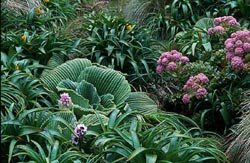Aussie megaherbs may have thrived in Antarctica 2 million years ago
 Melbourne, Mar 20: A daisy-like ‘mega-herb’ found in Australia and New Zealand's sub-Antarctic islands may have one thrived in Antartica nearly 2 million years ago, before the last ice age.
Melbourne, Mar 20: A daisy-like ‘mega-herb’ found in Australia and New Zealand's sub-Antarctic islands may have one thrived in Antartica nearly 2 million years ago, before the last ice age.
Researchers from Landcare Research in New Zealand led by Dr Steve Wagstaff studied species of giant daisies known as Pleurophyllum, which form huge arrangements of leaves, topped by clusters of lavender coloured flowers up to a metre tall.
These flowers, commonly known as megaherbs, are found in plenty on the tiny islands such as the Snares, Auckland and Campbell island groups.
To determine whether these megaherbs came to the islands from Antarctica, the boffins compared their genetic makeup to those of related plant species found in Australia, New Zealand and elsewhere.
After adding the data with information from fossils, the scientists came up with a 'molecular clock' on whose basis they could find out how long ago different plant species had diverged from one another.
Based on this, they determined that these megaherbs probably came from Antarctica before the last ice age.
"When you put all this together it looks like this particular group was probably on Antarctica before the last ice age, and that they migrated by stepping stones onto the sub-Antarctic islands," ABC online quoted co-author Dr Chris Quinn, as saying.
The researchers say that though conditions on Antarctica itself became inhospitable to many plants when the ice age began about 2 million years ago, the conditions on small islands further north were ideal.
From there, the boffins suggest, the plants continued evolving into smaller species and migrating further north into New Zealand and probably Australia.
The study appears online on the Nature Precedings pre-print service. (ANI)